engine FIAT PUNTO 2020 Owner handbook (in English)
[x] Cancel search | Manufacturer: FIAT, Model Year: 2020, Model line: PUNTO, Model: FIAT PUNTO 2020Pages: 219, PDF Size: 9.82 MB
Page 93 of 219
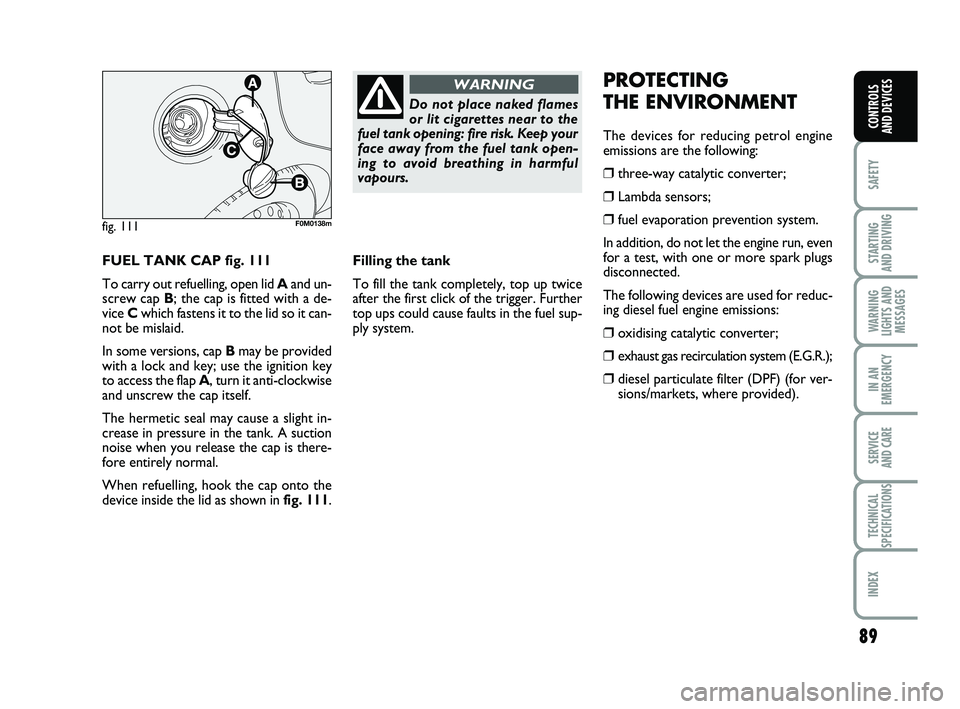
89
SAFETY
STARTING
AND DRIVING
WARNING
LIGHTS AND MESSAGES
IN AN
EMERGENCY
SERVICE
AND CARE
TECHNICAL
SPECIFICATIONS
INDEX
CONTROLS
AND DEVICES
FUEL TANK CAP fig. 111
To carry out refuelling, open lid A and un-
screw cap B ; the cap is fitted with a de-
vice Cwhich fastens it to the lid so it can-
not be mislaid.
In some versions, cap B may be provided
with a lock and key; use the ignition key
to access the flap A, turn it anti-clockwise
and unscrew the cap itself.
The hermetic seal may cause a slight in-
crease in pressure in the tank. A suction
noise when you release the cap is there-
fore entirely normal.
When refuelling, hook the cap onto the
device inside the lid as shown in fig. 111.
fig. 111F0M0138m
Do not place naked flames
or lit cigarettes near to the
fuel tank opening: fire risk. Keep your
face away from the fuel tank open-
ing to avoid breathing in harmful
vapours.
WARNING
Filling the tank
To fill the tank completely, top up twice
after the first click of the trigger. Further
top ups could cause faults in the fuel sup-
ply system.
PROTECTING
THE ENVIRONMENT
The devices for reducing petrol engine
emissions are the following:
❒three-way catalytic converter;
❒Lambda sensors;
❒fuel evaporation prevention system.
In addition, do not let the engine run, even
for a test, with one or more spark plugs
disconnected.
The following devices are used for reduc-
ing diesel fuel engine emissions:
❒oxidising catalytic converter;
❒exhaust gas recirculation system (E.G.R.);
❒diesel particulate filter (DPF) (for ver- sions/markets, where provided).
070-090 PUNTO POP 1ed EN 24/03/14 11:36 Pagina 89
Page 94 of 219
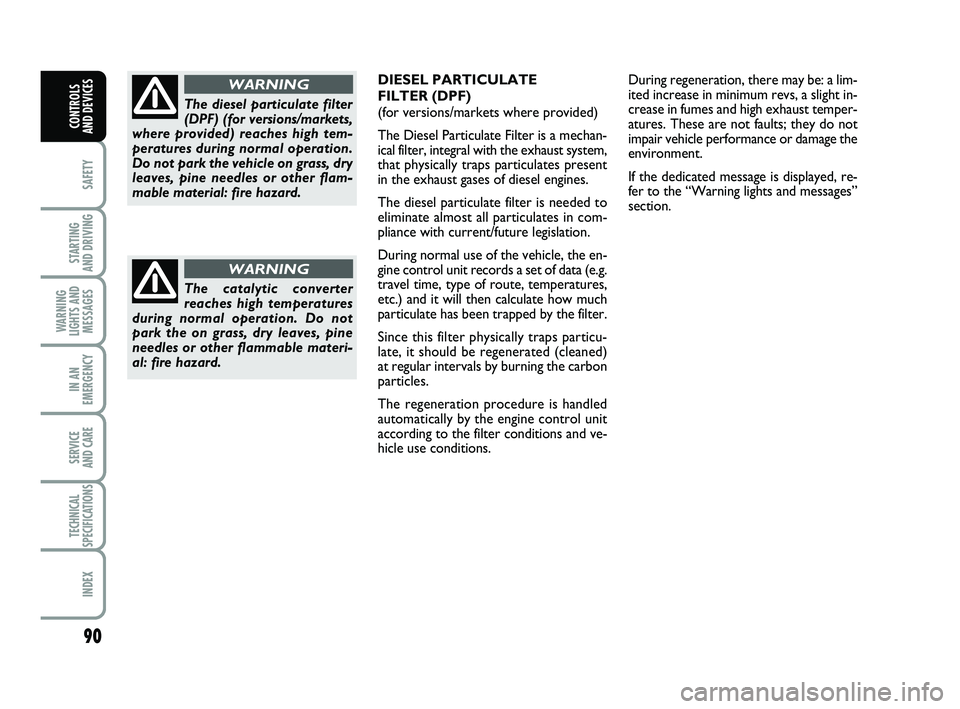
90
SAFETY
STARTING
AND DRIVING
WARNING
LIGHTS AND MESSAGES
IN AN
EMERGENCY
SERVICE
AND CARE
TECHNICAL
SPECIFICATIONS
INDEX
CONTROLS
AND DEVICES
The catalytic converter
reaches high temperatures
during normal operation. Do not
park the on grass, dry leaves, pine
needles or other flammable materi-
al: fire hazard.
WARNING
DIESEL PARTICULATE
FILTER (DPF)
(for versions/markets where provided)
The Diesel Particulate Filter is a mechan-
ical filter, integral with the exhaust system,
that physically traps particulates present
in the exhaust gases of diesel engines.
The diesel particulate filter is needed to
eliminate almost all particulates in com-
pliance with current/future legislation.
During normal use of the vehicle, the en-
gine control unit records a set of data (e.g.
travel time, type of route, temperatures,
etc.) and it will then calculate how much
particulate has been trapped by the filter.
Since this filter physically traps particu-
late, it should be regenerated (cleaned)
at regular intervals by burning the carbon
particles.
The regeneration procedure is handled
automatically by the engine control unit
according to the filter conditions and ve-
hicle use conditions. During regeneration, there may be: a lim-
ited increase in minimum revs, a slight in-
crease in fumes and high exhaust temper-
atures. These are not faults; they do not
impair vehicle performance or damage the
environment.
If the dedicated message is displayed, re-
fer to the “Warning lights and messages”
section.
The diesel particulate filter
(DPF) (for versions/markets,
where provided) reaches high tem-
peratures during normal operation.
Do not park the vehicle on grass, dry
leaves, pine needles or other flam-
mable material: fire hazard.
WARNING
070-090 PUNTO POP 1ed EN 24/03/14 11:36 Pagina 90
Page 115 of 219
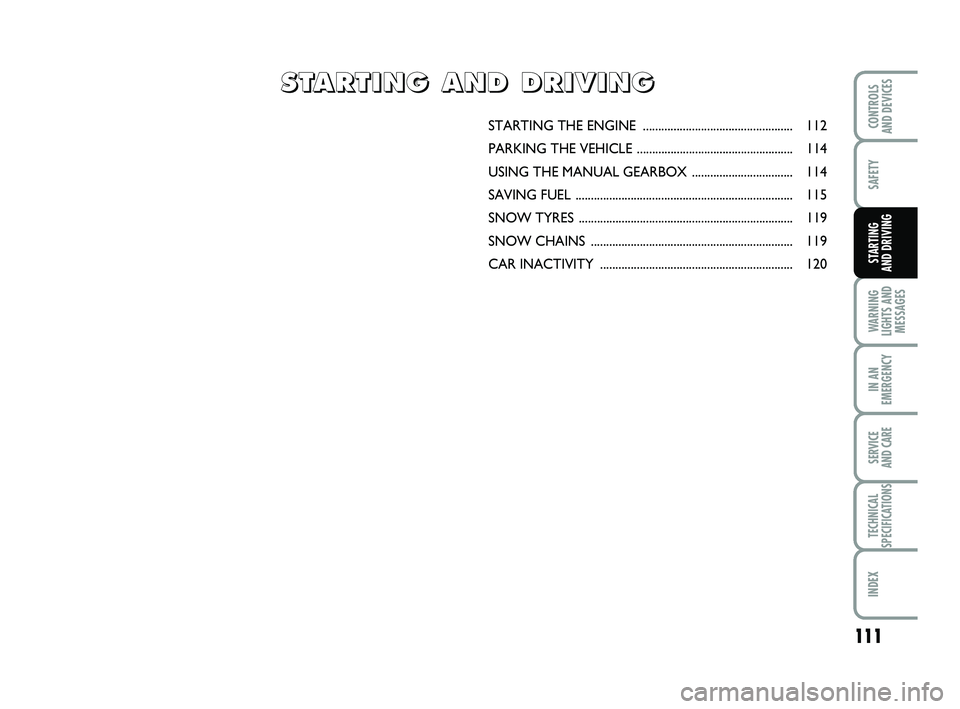
111
SAFETY
WARNING
LIGHTS AND MESSAGES
IN AN
EMERGENCY
SERVICE
AND CARE
TECHNICAL
SPECIFICATIONS
INDEX
CONTROLS
AND DEVICES
STARTING
AND DRIVING
STARTING THE ENGINE ................................................. 112
PARKING THE VEHIC LE ................................................... 114
USING THE MANU AL GEARBOX ................................. 114
SAVING FUEL ....................................................................... 115
SNOW TYRES ......................................................................\
119
SNOW CHAINS .................................................................. 119
CAR INACTIVITY ............................................................... 120
S
S
T
T
A
A
R
R
T
T
I
I
N
N
G
G
A
A
N
N
D
D
D
D
R
R
I
I
V
V
I
I
N
N
G
G
111-120 PUNTO POP 1ed EN 24/09/13 14.29 Pagina 111
Page 116 of 219
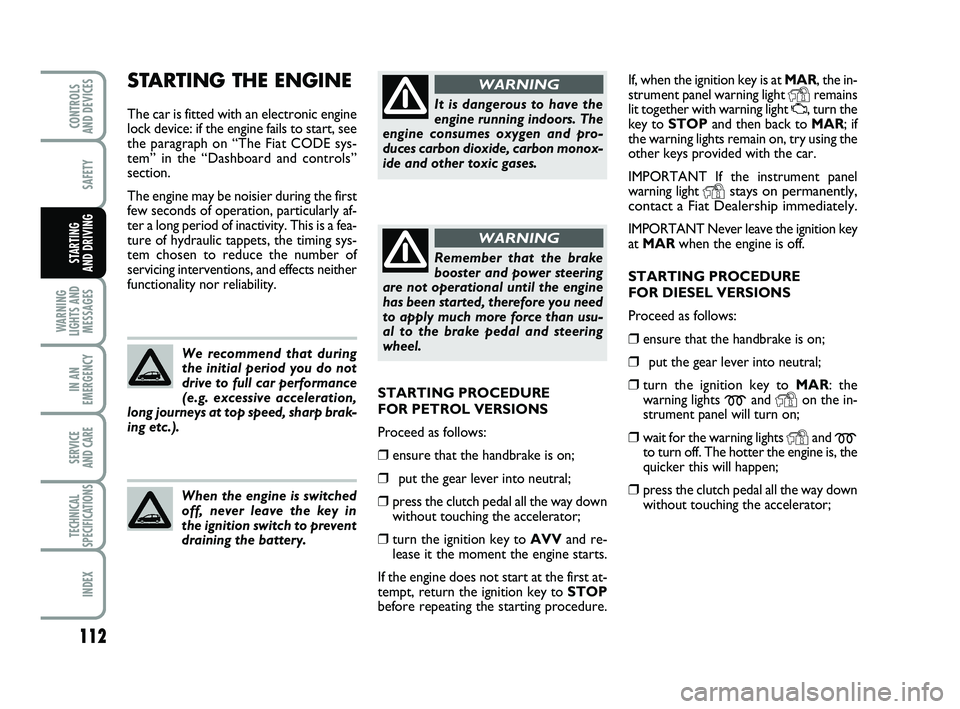
112
SAFETY
WARNING
LIGHTS AND MESSAGES
IN AN
EMERGENCY
SERVICE
AND CARE
TECHNICAL
SPECIFICATIONS
INDEX
CONTROLS
AND DEVICES
STARTING
AND DRIVING
If, when the ignition key is at MAR, the in-
strument panel warning light
Yremains
lit together with warning light U, turn the
key to STOP and then back to MAR; if
the warning lights remain on, try using the
other keys provided with the car.
IMPORTANT If the instrument panel
warning light
Ystays on permanently,
contact a Fiat Dealership immediately.
IMPORTANT Never leave the ignition key
at MAR when the engine is off.
STARTING PROCEDURE
FOR DIESEL VERSIONS
Proceed as follows:
❒ensure that the handbrake is on;
❒put the gear lever into neutral;
❒turn the ignition key to MAR: the
warning lights
mand Yon the in-
strument panel will turn on;
❒wait for the warning lights Yand mto turn off. The hotter the engine is, the
quicker this will happen;
❒press the clutch pedal all the way down without touching the accelerator;
STARTING THE ENGINE
The car is fitted with an electronic engine
lock device: if the engine fails to start, see
the paragraph on “The Fiat CODE sys-
tem” in the “Dashboard and controls”
section.
The engine may be noisier during the first
few seconds of operation, particularly af-
ter a long period of inactivity. This is a fea-
ture of hydraulic tappets, the timing sys-
tem chosen to reduce the number of
servicing interventions, and effects neither
functionality nor reliability.
We recommend that during
the initial period you do not
drive to full car performance
(e.g. excessive acceleration,
long journeys at top speed, sharp brak-
ing etc.).
When the engine is switched
off, never leave the key in
the ignition switch to prevent
draining the battery.
It is dangerous to have the
engine running indoors. The
engine consumes oxygen and pro-
duces carbon dioxide, carbon monox-
ide and other toxic gases.
WARNING
Remember that the brake
booster and power steering
are not operational until the engine
has been started, therefore you need
to apply much more force than usu-
al to the brake pedal and steering
wheel.
WARNING
STARTING PROCEDURE
FOR PETROL VERSIONS
Proceed as follows:
❒ensure that the handbrake is on;
❒put the gear lever into neutral;
❒press the clutch pedal all the way down without touching the accelerator;
❒turn the ignition key to AVVand re-
lease it the moment the engine starts.
If the engine does not start at the first at-
tempt, return the ignition key to STOP
before repeating the starting procedure.
111-120 PUNTO POP 1ed EN 24/09/13 14.29 Pagina 112
Page 117 of 219
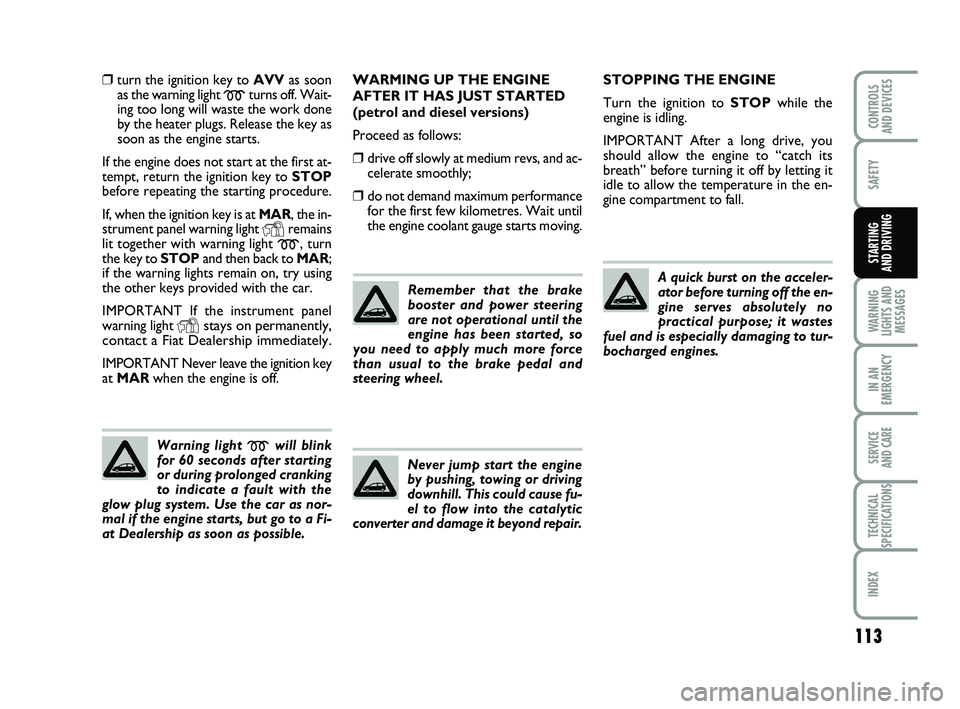
113
SAFETY
WARNING
LIGHTS AND MESSAGES
IN AN
EMERGENCY
SERVICE
AND CARE
TECHNICAL
SPECIFICATIONS
INDEX
CONTROLS
AND DEVICES
STARTING
AND DRIVING
❒turn the ignition key to AVV as soon
as the warning light
mturns off. Wait-
ing too long will waste the work done
by the heater plugs. Release the key as
soon as the engine starts.
If the engine does not start at the first at-
tempt, return the ignition key to STOP
before repeating the starting procedure.
If, when the ignition key is at MAR, the in-
strument panel warning light
Yremains
lit together with warning light
m, turn
the key to STOP and then back to MAR;
if the warning lights remain on, try using
the other keys provided with the car.
IMPORTANT If the instrument panel
warning light
Ystays on permanently,
contact a Fiat Dealership immediately.
IMPORTANT Never leave the ignition key
at MAR when the engine is off.
Warning light
mwill blink
for 60 seconds after starting
or during prolonged cranking
to indicate a fault with the
glow plug system. Use the car as nor-
mal if the engine starts, but go to a Fi-
at Dealership as soon as possible.
WARMING UP THE ENGINE
AFTER IT HAS JUST STARTED
(petrol and diesel versions)
Proceed as follows:
❒drive off slowly at medium revs, and ac- celerate smoothly;
❒do not demand maximum performancefor the first few kilometres. Wait until
the engine coolant gauge starts moving.
Remember that the brake
booster and power steering
are not operational until the
engine has been started, so
you need to apply much more force
than usual to the brake pedal and
steering wheel.
Never jump start the engine
by pushing, towing or driving
downhill. This could cause fu-
el to flow into the catalytic
converter and damage it beyond repair.
STOPPING THE ENGINE
Turn the ignition to STOP while the
engine is idling.
IMPORTANT After a long drive, you
should allow the engine to “catch its
breath” before turning it off by letting it
idle to allow the temperature in the en-
gine compartment to fall.
A quick burst on the acceler-
ator before turning off the en-
gine serves absolutely no
practical purpose; it wastes
fuel and is especially damaging to tur-
bocharged engines.
111-120 PUNTO POP 1ed EN 03/10/13 13.21 Pagina 113
Page 118 of 219
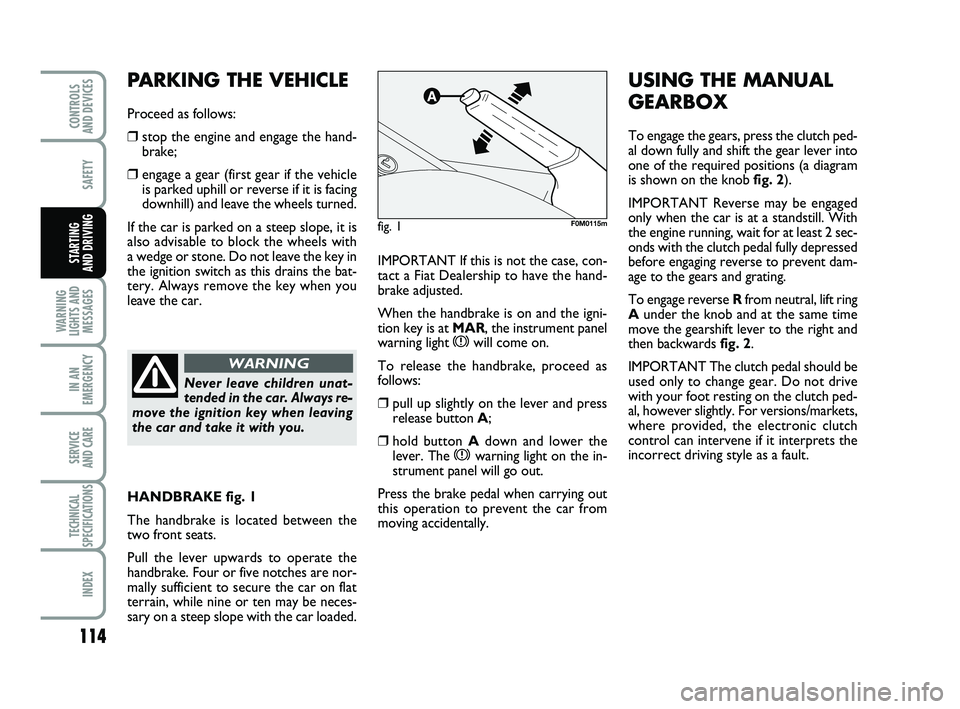
114
SAFETY
WARNING
LIGHTS AND MESSAGES
IN AN
EMERGENCY
SERVICE
AND CARE
TECHNICAL
SPECIFICATIONS
INDEX
CONTROLS
AND DEVICES
STARTING
AND DRIVINGIMPORTANT If this is not the case, con-
tact a Fiat Dealership to have the hand-
brake adjusted.
When the handbrake is on and the igni-
tion key is at MAR, the instrument panel
warning light
xwill come on.
To release the handbrake, proceed as
follows:
❒pull up slightly on the lever and press
release button A;
❒hold button A down and lower the
lever. The xwarning light on the in-
strument panel will go out.
Press the brake pedal when carrying out
this operation to prevent the car from
moving accidentally.
PARKING THE VEHICLE
Proceed as follows:
❒stop the engine and engage the hand- brake;
❒engage a gear (first gear if the vehicleis parked uphill or reverse if it is facing
downhill) and leave the wheels turned.
If the car is parked on a steep slope, it is
also advisable to block the wheels with
a wedge or stone. Do not leave the key in
the ignition switch as this drains the bat-
tery. Always remove the key when you
leave the car.
Never leave children unat-
tended in the car. Always re-
move the ignition key when leaving
the car and take it with you.
WARNING
fig. 1F0M0115m
HANDBRAKE fig. 1
The handbrake is located between the
two front seats.
Pull the lever upwards to operate the
handbrake. Four or five notches are nor-
mally sufficient to secure the car on flat
terrain, while nine or ten may be neces-
sary on a steep slope with the car loaded.
USING THE MANUAL
GEARBOX
To engage the gears, press the clutch ped-
al down fully and shift the gear lever into
one of the required positions (a diagram
is shown on the knob fig. 2).
IMPORTANT Reverse may be engaged
only when the car is at a standstill. With
the engine running, wait for at least 2 sec-
onds with the clutch pedal fully depressed
before engaging reverse to prevent dam-
age to the gears and grating.
To engage reverse R from neutral, lift ring
A under the knob and at the same time
move the gearshift lever to the right and
then backwards fig. 2.
IMPORTANT The clutch pedal should be
used only to change gear. Do not drive
with your foot resting on the clutch ped-
al, however slightly. For versions/markets,
where provided, the electronic clutch
control can intervene if it interprets the
incorrect driving style as a fault.
111-120 PUNTO POP 1ed EN 24/09/13 14.29 Pagina 114
Page 120 of 219
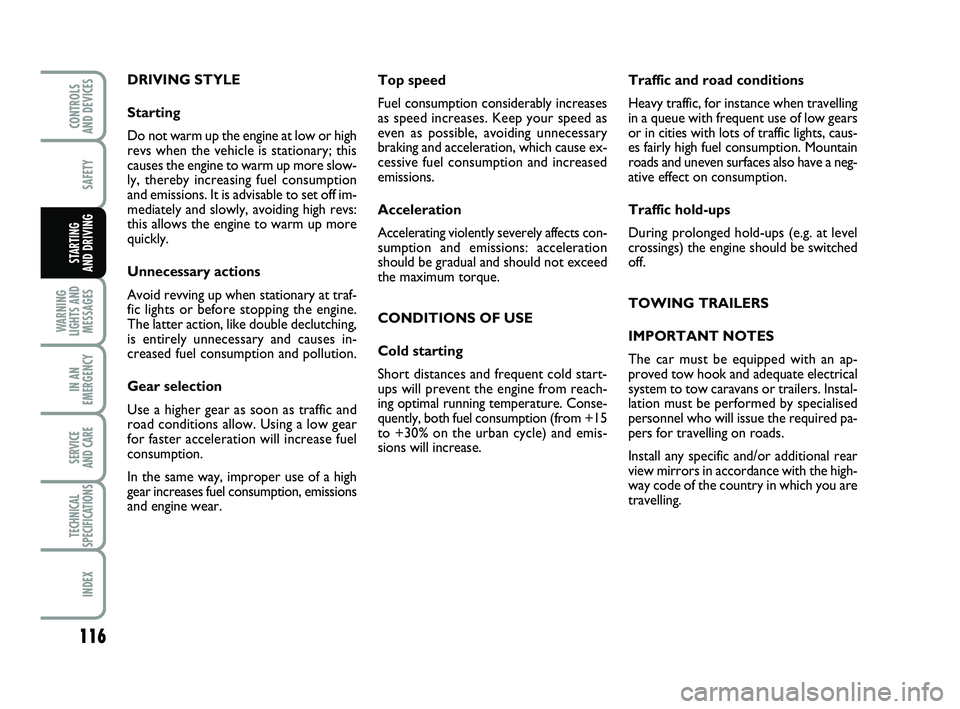
116
SAFETY
WARNING
LIGHTS AND MESSAGES
IN AN
EMERGENCY
SERVICE
AND CARE
TECHNICAL
SPECIFICATIONS
INDEX
CONTROLS
AND DEVICES
STARTING
AND DRIVING
DRIVING STYLE
Starting
Do not warm up the engine at low or high
revs when the vehicle is stationary; this
causes the engine to warm up more slow-
ly, thereby increasing fuel consumption
and emissions. It is advisable to set off im-
mediately and slowly, avoiding high revs:
this allows the engine to warm up more
quickly.
Unnecessary actions
Avoid revving up when stationary at traf-
fic lights or before stopping the engine.
The latter action, like double declutching,
is entirely unnecessary and causes in-
creased fuel consumption and pollution.
Gear selection
Use a higher gear as soon as traffic and
road conditions allow. Using a low gear
for faster acceleration will increase fuel
consumption.
In the same way, improper use of a high
gear increases fuel consumption, emissions
and engine wear. Traffic and road conditions
Heavy traffic, for instance when travelling
in a queue with frequent use of low gears
or in cities with lots of traffic lights, caus-
es fairly high fuel consumption. Mountain
roads and uneven surfaces also have a neg-
ative effect on consumption.
Traffic hold-ups
During prolonged hold-ups (e.g. at level
crossings) the engine should be switched
off.
TOWING TRAILERS
IMPORTANT NOTES
The car must be equipped with an ap-
proved tow hook and adequate electrical
system to tow caravans or trailers. Instal-
lation must be performed by specialised
personnel who will issue the required pa-
pers for travelling on roads.
Install any specific and/or additional rear
view mirrors in accordance with the high-
way code of the country in which you are
travelling.
Top speed
Fuel consumption considerably increases
as speed increases. Keep your speed as
even as possible, avoiding unnecessary
braking and acceleration, which cause ex-
cessive fuel consumption and increased
emissions.
Acceleration
Accelerating violently severely affects con-
sumption and emissions: acceleration
should be gradual and should not exceed
the maximum torque.
CONDITIONS OF USE
Cold starting
Short distances and frequent cold start-
ups will prevent the engine from reach-
ing optimal running temperature. Conse-
quently, both fuel consumption (from +15
to +30% on the urban cycle) and emis-
sions will increase.
111-120 PUNTO POP 1ed EN 24/09/13 14.29 Pagina 116
Page 121 of 219
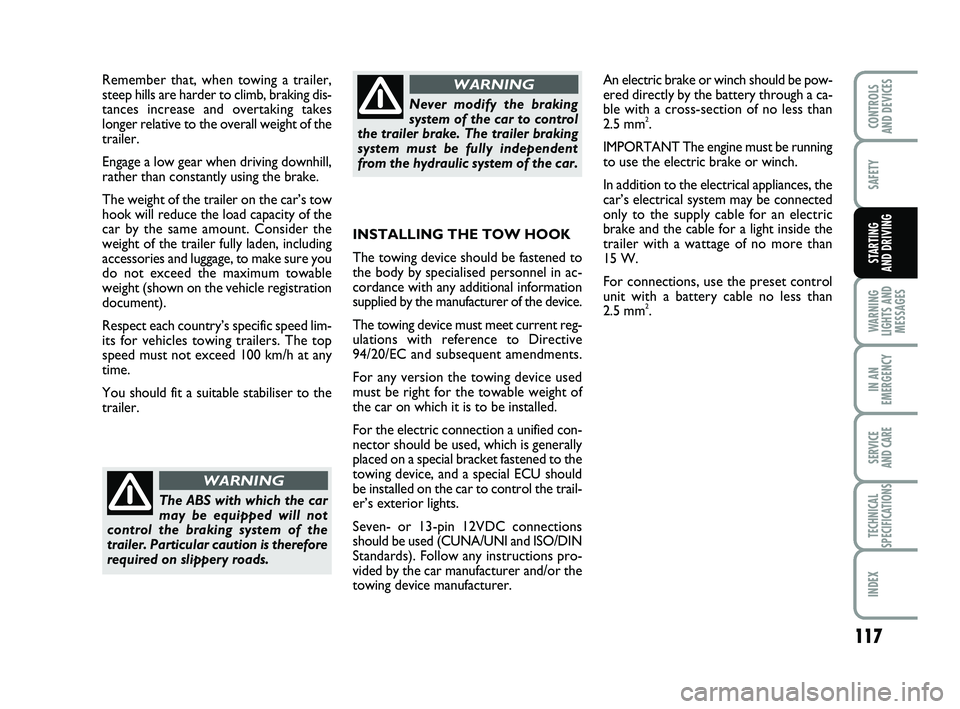
117
SAFETY
WARNING
LIGHTS AND MESSAGES
IN AN
EMERGENCY
SERVICE
AND CARE
TECHNICAL
SPECIFICATIONS
INDEX
CONTROLS
AND DEVICES
STARTING
AND DRIVING
Remember that, when towing a trailer,
steep hills are harder to climb, braking dis-
tances increase and overtaking takes
longer relative to the overall weight of the
trailer.
Engage a low gear when driving downhill,
rather than constantly using the brake.
The weight of the trailer on the car’s tow
hook will reduce the load capacity of the
car by the same amount. Consider the
weight of the trailer fully laden, including
accessories and luggage, to make sure you
do not exceed the maximum towable
weight (shown on the vehicle registration
document).
Respect each country’s specific speed lim-
its for vehicles towing trailers. The top
speed must not exceed 100 km/h at any
time.
You should fit a suitable stabiliser to the
trailer.
The ABS with which the car
may be equipped will not
control the braking system of the
trailer. Particular caution is therefore
required on slippery roads.
WARNING
Never modify the braking
system of the car to control
the trailer brake. The trailer braking
system must be fully independent
from the hydraulic system of the car.
WARNING
INSTALLING THE TOW HOOK
The towing device should be fastened to
the body by specialised personnel in ac-
cordance with any additional information
supplied by the manufacturer of the device.
The towing device must meet current reg-
ulations with reference to Directive
94/20/EC and subsequent amendments.
For any version the towing device used
must be right for the towable weight of
the car on which it is to be installed.
For the electric connection a unified con-
nector should be used, which is generally
placed on a special bracket fastened to the
towing device, and a special ECU should
be installed on the car to control the trail-
er’s exterior lights.
Seven- or 13-pin 12VDC connections
should be used (CUNA/UNI and ISO/DIN
Standards). Follow any instructions pro-
vided by the car manufacturer and/or the
towing device manufacturer. An electric brake or winch should be pow-
ered directly by the battery through a ca-
ble with a cross-section of no less than
2.5 mm
2.
IMPORTANT The engine must be running
to use the electric brake or winch.
In addition to the electrical appliances, the
car’s electrical system may be connected
only to the supply cable for an electric
brake and the cable for a light inside the
trailer with a wattage of no more than
15 W.
For connections, use the preset control
unit with a battery cable no less than
2.5 mm
2.
111-120 PUNTO POP 1ed EN 24/09/13 14.29 Pagina 117
Page 124 of 219
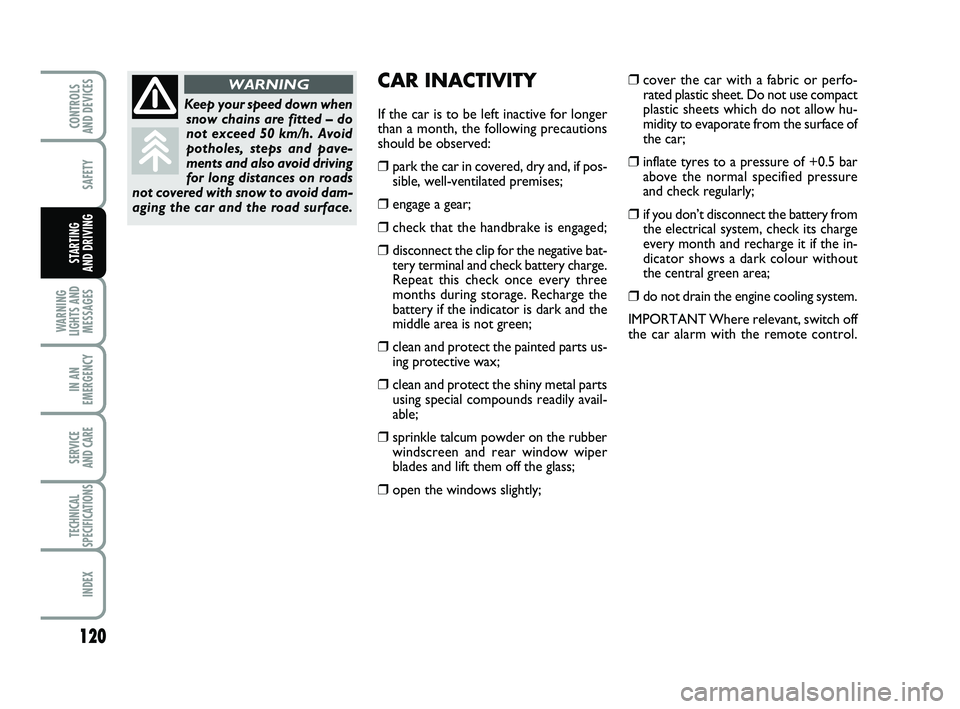
120
SAFETY
WARNING
LIGHTS AND MESSAGES
IN AN
EMERGENCY
SERVICE
AND CARE
TECHNICAL
SPECIFICATIONS
INDEX
CONTROLS
AND DEVICES
STARTING
AND DRIVING
CAR INACTIVITY
If the car is to be left inactive for longer
than a month, the following precautions
should be observed:
❒park the car in covered, dry and, if pos- sible, well-ventilated premises;
❒engage a gear;
❒check that the handbrake is engaged;
❒disconnect the clip for the negative bat-tery terminal and check battery charge.
Repeat this check once every three
months during storage. Recharge the
battery if the indicator is dark and the
middle area is not green;
❒clean and protect the painted parts us-ing protective wax;
❒clean and protect the shiny metal partsusing special compounds readily avail-
able;
❒sprinkle talcum powder on the rubberwindscreen and rear window wiper
blades and lift them off the glass;
❒open the windows slightly;
❒cover the car with a fabric or perfo-rated plastic sheet. Do not use compact
plastic sheets which do not allow hu-
midity to evaporate from the surface of
the car;
❒inflate tyres to a pressure of +0.5 barabove the normal specified pressure
and check regularly;
❒if you don’t disconnect the battery fromthe electrical system, check its charge
every month and recharge it if the in-
dicator shows a dark colour without
the central green area;
❒do not drain the engine cooling system.
IMPORTANT Where relevant, switch off
the car alarm with the remote control.
Keep your speed down when snow chains are fitted – do
not exceed 50 km/h. Avoid
potholes, steps and pave-
ments and also avoid driving
for long distances on roads
not covered with snow to avoid dam-
aging the car and the road surface.
WARNING
111-120 PUNTO POP 1ed EN 24/09/13 14.29 Pagina 120
Page 125 of 219
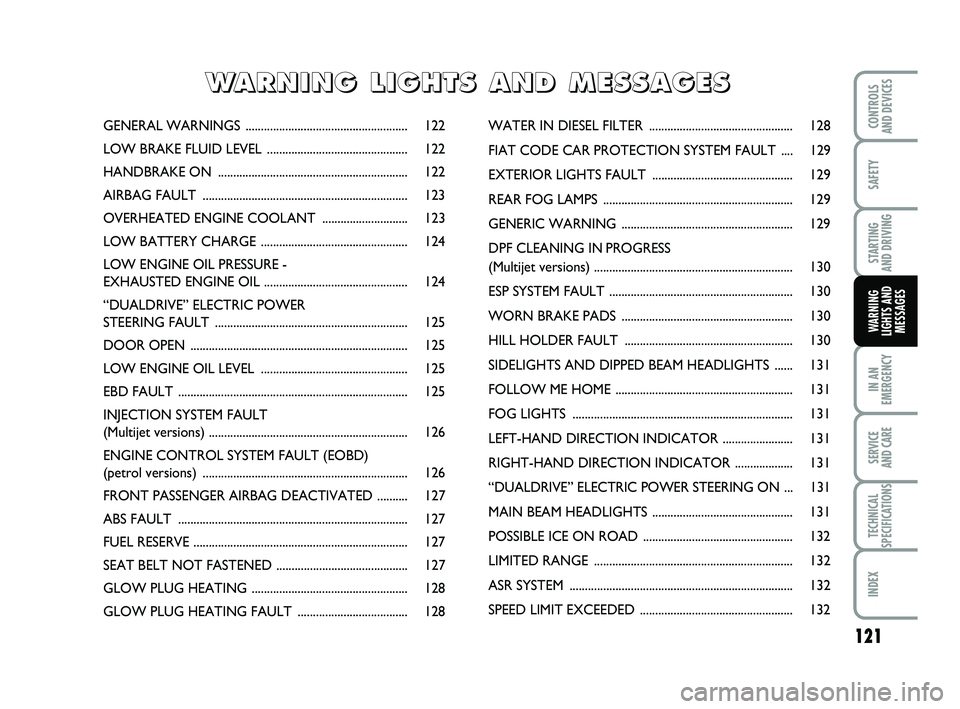
121
SAFETY
STARTING
AND DRIVING
IN AN
EMERGENCY
SERVICE
AND CARE
TECHNICAL
SPECIFICATIONS
INDEX
CONTROLS
AND DEVICES
WARNING
LIGHTS AND MESSAGES
GENERAL WARNINGS ..................................................... 122
LOW BRAKE FLUID LEVEL .............................................. 122
HANDBRAKE ON .............................................................. 122
AIRBAG FAULT ................................................................... 123
OVERHEATED ENGINE COOLANT ............................ 123
LOW BATTERY CHARGE ................................................ 124
LOW ENGINE OIL PRESSURE -
EXHAUSTED ENGINE OIL ............................................... 124
“DUALDRIVE” ELECTRIC POWER
STEERING FAU LT ............................................................... 125
DOOR OPEN .......................................................................\
125
LOW ENGINE OIL LEVEL ................................................ 125
EBD FAULT .......................................................................\
.... 125
INJECTION SYSTEM FAULT
(Multijet vers ions) ................................................................. 126
ENGINE CONTROL SYSTEM FAULT (EOBD)
(petrol vers ions) ................................................................... 126
FRONT PASSENGER AIR BAG DEACTIVATED .......... 127
ABS FAULT .......................................................................\
.... 127
FUEL RESERVE ...................................................................... 127
SEAT BELT NOT FASTENED ........................................... 127
GLOW PLUG H EATING ................................................... 128
GLOW PLUG HEATIN G FAULT .................................... 128 WATER IN DIES
EL FILTER ............................................... 128
FIAT CODE CAR PROTECTION SYSTEM FAULT .... 129
EXTERIOR LIG HTS FAULT .............................................. 129
REAR FOG LAMPS .............................................................. 129
GENERIC WAR NING ........................................................ 129
DPF CLEANING IN PROGRESS
(Multijet versions) ................................................................. 130
ESP SYSTEM FAU LT ............................................................ 130
WORN BRAKE PADS ........................................................ 130
HILL HOLDER FAULT ....................................................... 130
SIDELIGHTS AND DIPP ED BEAM HEADLIGHTS ...... 131
FOLLOW ME HO ME .......................................................... 131
FOG LIGHTS ........................................................................\
131
LEFT-HAND DIRECTION INDICAT OR ....................... 131
RIGHT-HAND DIRECT ION INDICATOR ................... 131
“DUALDRIVE” ELECTRIC POWER STEERING ON ... 131
MAIN BEAM HEADLIGHTS .............................................. 131
POSSIBLE ICE ON ROAD .................................................
132
LIMITED RANGE ................................................................. 132
ASR SYSTEM ......................................................................\
... 132
SPEED LIMIT EXCEEDED .................................................. 132
W
W
A
A
R
R
N
N
I
I
N
N
G
G
L
L
I
I
G
G
H
H
T
T
S
S
A
A
N
N
D
D
M
M
E
E
S
S
S
S
A
A
G
G
E
E
S
S
121-132 PUNTO POP 1ed EN 29/08/13 15.03 Pagina 121